It looks like you're using an Ad Blocker.
Please white-list or disable AboveTopSecret.com in your ad-blocking tool.
Thank you.
Some features of ATS will be disabled while you continue to use an ad-blocker.
share:
Here are some images processed with Mars Express DTM data. The images are screen caps from a 3D viewing program.
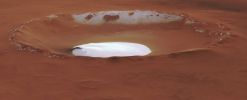
files.abovetopsecret.com...
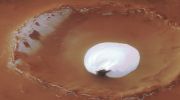
files.abovetopsecret.com...
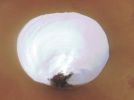
files.abovetopsecret.com...
Here are the official ESA images.
It does not say where the water ice came from. Rain? Snow? Ground Water? Any ideas where the water came from?

files.abovetopsecret.com...

files.abovetopsecret.com...

files.abovetopsecret.com...
Here are the official ESA images.
The crater is 35 kilometres wide and has a maximum depth of approximately 2 kilometres beneath the crater rim. The circular patch of bright material located at the centre of the crater is residual water ice.
It does not say where the water ice came from. Rain? Snow? Ground Water? Any ideas where the water came from?
It cannot be frozen carbon dioxide since carbon dioxide ice had already disappeared from the north polar cap at the time the image was taken (late summer in the Martian northern hemisphere).
edit on 19-11-2017 by LookingAtMars because: Questions
a reply to: LookingAtMars
I would think that would be just a perfect place to land humans provided they have the means to turn that ice into water. Maybe an aquaponics factory. Martian talapia is on the menu!
I would think that would be just a perfect place to land humans provided they have the means to turn that ice into water. Maybe an aquaponics factory. Martian talapia is on the menu!
im going to go ahead and say its methane ice and not 'water' ice on mars. last i checked, water in any form is made up elements not sustainable on
Mars, not based on sci fi, but distance from the sun, radiation, lack of anything able to produce water, and lack of water born vegetation or
terraformation water produces.
im honestly shocked that they're saying its water based solely on images, by that science europa and IO is full of water
im honestly shocked that they're saying its water based solely on images, by that science europa and IO is full of water
a reply to: odzeandennz
www.esa.int...
Methane sublimates at much lower temperatures than water does. Pretty certain to be water ice and not much reason to think otherwise. The 2005 article:
im going to go ahead and say its methane ice and not 'water' ice on mars.
This white patch is present all year round, as the temperature and pressure conditions do not favour the sublimation of water ice. It cannot be frozen carbon dioxide since carbon dioxide ice had already disappeared from the north polar cap at the time the image was taken (late summer in the Martian northern hemisphere).
www.esa.int...
edit on 11/19/2017 by Phage because: (no reason given)
a reply to: odzeandennz
Did you read the link in the OP. It gives pretty solid reasons why it is thought to be water ice.
EDIT: Looks like Phage read it.
Did you read the link in the OP. It gives pretty solid reasons why it is thought to be water ice.
EDIT: Looks like Phage read it.
edit on 19-11-2017 by LookingAtMars because: Phage
originally posted by: Phage
a reply to: odzeandennz
Methane sublimates at much lower temperatures than water does. Pretty certain to be water ice and not much reason to think otherwise. The 2005 article:
im going to go ahead and say its methane ice and not 'water' ice on mars.
This white patch is present all year round, as the temperature and pressure conditions do not favour the sublimation of water ice. It cannot be frozen carbon dioxide since carbon dioxide ice had already disappeared from the north polar cap at the time the image was taken (late summer in the Martian northern hemisphere).
www.esa.int...
yes i read that. what im questioning is how could it be water ice at all. not saying it doesn't look like water ice, but why or how would a patch be the sole representative of water ice on mars with no other water-born after effects, or how could water be sustained in any form whilst interacting with the radiation and the atmospheric make up of mars which is carbon dioxide and argon, or the extreme swing temperatures and of course the lack of hydrogen at all albeit less than .01 % oxygen..
since when do what things look like are what they are
edit on 19-11-2017 by odzeandennz because: (no reason given)
a reply to: odzeandennz
It is not the "sole representative of water ice on mars."
spaceweather.com...
What does radiation and argon have to do with water? But yes, the very low atmospheric pressure on Mars means that water ice can only exist at very low temperatures, otherwise it sublimates away to condense into ice another (colder) day.
It is not the "sole representative of water ice on mars."
spaceweather.com...
What does radiation and argon have to do with water? But yes, the very low atmospheric pressure on Mars means that water ice can only exist at very low temperatures, otherwise it sublimates away to condense into ice another (colder) day.
edit on 11/19/2017 by Phage because: (no reason given)
a reply to: LookingAtMars
Pole temperature range on Mars :
70 degrees F. to minus 195 F.
Approximately.
Freezing temperature of methane=
minus 295.6 F.
Good Stuff!
S&F
Pole temperature range on Mars :
70 degrees F. to minus 195 F.
Approximately.
Freezing temperature of methane=
minus 295.6 F.
Good Stuff!
S&F
originally posted by: LookingAtMars
It does not say where the water ice came from. Rain? Snow? Ground Water? Any ideas where the water came from?
Water vapour in the atmosphere. It can condense onto the surface as ice.
BTW, that's a very cool feature. I've never seen such a large formation that's considered to be water ice.
Here's a HiRISE detail:

www.uahirise.org...
You can see here that it's actually frosted-over sand dunes.
An interesting feature on the ice:
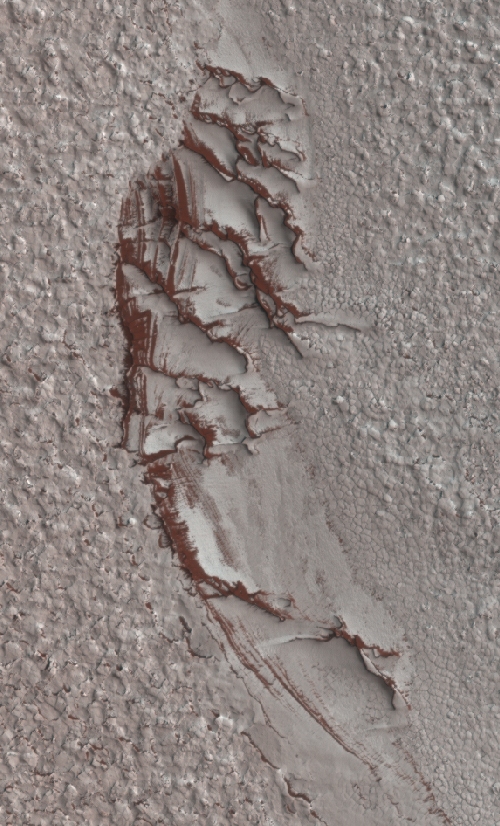
edit on 19-11-2017 by wildespace because: (no reason given)
a reply to: wildespace
Thanks for the HiRise image. That seems to be a lot of water ice to be from condensation. Could it have been a frozen lake that has sublimed away over eons and now that is all that is left?
Thanks for the HiRise image. That seems to be a lot of water ice to be from condensation. Could it have been a frozen lake that has sublimed away over eons and now that is all that is left?
originally posted by: LookingAtMars
a reply to: wildespace
Thanks for the HiRise image. That seems to be a lot of water ice to be from condensation. Could it have been a frozen lake that has sublimed away over eons and now that is all that is left?
It's just a thin layer of ice on top of a dune mound. Many craters have such a dune mound, for example the famous Victoria crater. It seems the mound is cold enough and under enough atmospheric pressure to facilitate water condensation and keep it there.
I would say its sulphate. You see alot of it in the rover tracks. Saying its water ice is stretching it.
a reply to: wildespace
Agree for the most part.
Agree for the most part.
edit on 19-11-2017 by LookingAtMars because: Reading
originally posted by: 0bserver1
What's the dark pluim of smoke doing there at the bottom?
It's simply exposed sand: hirise-pds.lpl.arizona.edu...
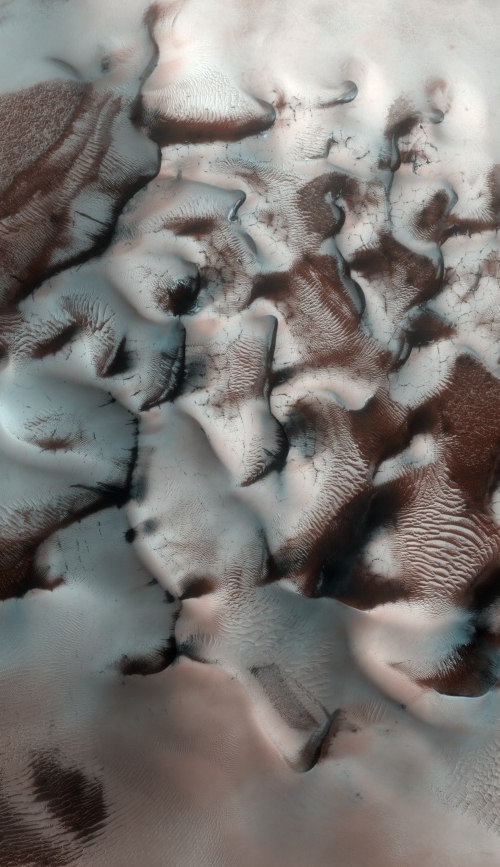
Very beautiful detail when seen upclose:

At different seasons, that patch is remarkably ice-free: hirise-pds.lpl.arizona.edu...
~~~
And here's some more beautiful detail of the ice patch:

edit on 19-11-2017 by wildespace because: (no reason given)
That dark brown, disturbed area near the bottom of the original pic looks interesting. Would that not be a great place to check for some possible
microbial life? There are large, dome shaped features in that patch. Interesting indeed!
a reply to: Phage
argon and carbon dioxide are reactive. any hydrogen mix oxidizes immediately. water is still h2o, no matter what planet you are on.
this would mean the less than 0. 01% of hydrogen on mars is what is producing massive "water ice" at the poles...
until another research refutes this massive amount of water on mars i the form of ice...
even your link seems to think its still speculative
there's nothing wrong with inquisition and asking more questions, in fact its better than just quoting and believing whats simply written.
but ut seems there is some chance it may be frozen water; albeit the hydrogen would decompose in the mix of argon no matter what planet you are on.
argon and carbon dioxide are reactive. any hydrogen mix oxidizes immediately. water is still h2o, no matter what planet you are on.
this would mean the less than 0. 01% of hydrogen on mars is what is producing massive "water ice" at the poles...
until another research refutes this massive amount of water on mars i the form of ice...
even your link seems to think its still speculative
Some readers have asked, how do we know the white substance is not frozen CO2 (dry ice) instead of frozen water? Answer: Phoenix's landing site is too warm for dry ice. The average daily temperature is about -70 F while dry ice requires temperatures lower than about -109 F.
Finding water was one of the key goals of the Phoenix mission. Although H2O has trouble flowing as a liquid on the surface of Mars, it may be able to liquify, from time to time, just below the surface, providing a habitat for martian microbes. Exciting stuff! Stay tuned as the digging continues.
there's nothing wrong with inquisition and asking more questions, in fact its better than just quoting and believing whats simply written.
but ut seems there is some chance it may be frozen water; albeit the hydrogen would decompose in the mix of argon no matter what planet you are on.
new topics
-
Hate makes for strange bedfellows
US Political Madness: 1 hours ago -
Who guards the guards
US Political Madness: 3 hours ago -
Has Tesla manipulated data logs to cover up auto pilot crash?
Automotive Discussion: 5 hours ago -
whistleblower Captain Bill Uhouse on the Kingman UFO recovery
Aliens and UFOs: 10 hours ago
top topics
-
Lawsuit Seeks to ‘Ban the Jab’ in Florida
Diseases and Pandemics: 17 hours ago, 23 flags -
CIA botched its handling of sexual assault allegations, House intel report says
Breaking Alternative News: 15 hours ago, 11 flags -
whistleblower Captain Bill Uhouse on the Kingman UFO recovery
Aliens and UFOs: 10 hours ago, 10 flags -
Who guards the guards
US Political Madness: 3 hours ago, 7 flags -
Hate makes for strange bedfellows
US Political Madness: 1 hours ago, 6 flags -
1980s Arcade
General Chit Chat: 12 hours ago, 5 flags -
Teenager makes chess history becoming the youngest challenger for the world championship crown
Other Current Events: 14 hours ago, 4 flags -
Deadpool and Wolverine
Movies: 13 hours ago, 4 flags -
Has Tesla manipulated data logs to cover up auto pilot crash?
Automotive Discussion: 5 hours ago, 2 flags
active topics
-
Candidate TRUMP Now Has Crazy Judge JUAN MERCHAN After Him - The Stormy Daniels Hush-Money Case.
Political Conspiracies • 661 • : Annee -
IDF Intel Chief Resigns Over Hamas attack
Middle East Issues • 38 • : HopeForTheFuture -
Hate makes for strange bedfellows
US Political Madness • 7 • : budzprime69 -
Europe declares war on Russia?
World War Three • 62 • : 777Vader -
"We're All Hamas" Heard at Columbia University Protests
Social Issues and Civil Unrest • 222 • : FlyersFan -
1980s Arcade
General Chit Chat • 13 • : Bluntone22 -
British TV Presenter Refuses To Use Guest's Preferred Pronouns
Education and Media • 110 • : Annee -
Michael Avenatti Says He Will Testify FOR Trump
US Political Madness • 61 • : JadedGhost -
Who guards the guards
US Political Madness • 2 • : budzprime69 -
New whistleblower Jason Sands speaks on Twitter Spaces last night.
Aliens and UFOs • 41 • : baablacksheep1
